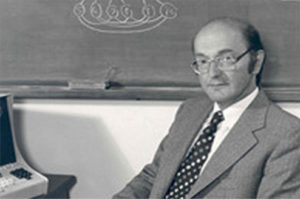
Date: 01/01/1965
In 1965, Donald Davies of the National Physical Laboratory (United Kingdom) proposed a national data network based on packet-switching.The proposal was not taken up nationally, but by 1970 he had designed and built the Mark I packet-switched network and proved the technology under operational conditions. By 1976 12 computers and 75 terminal devices were attached and more were added until the network was replaced in 1986.
Donald Watts Davies, was a Welsh computer scientist who was employed at the UK National Physical Laboratory (NPL). In 1965 he developed the concept of packet switching in computer networking, and implemented it in the NPL network. This was independent of the work of Paul Baran in the United States who had a similar idea in the early 1960s. The ARPANET project credited Davies primarily for his influence.
Early life
Davies was born in Treorchy in the Rhondda Valley, Wales. His father, a clerk at a coalmine, died a few months later, and his mother took Donald and his twin sister back to her home town of Portsmouth, where he went to school. He received a BSc degree in physics (1943) at Imperial College London, and then joined the war effort working as an assistant to Klaus Fuchs[ on the nuclear weapons Tube Alloys project at Birmingham University. He then returned to Imperial taking a first class degree in mathematics (1947); he was also awarded the Lubbock memorial Prize as the outstanding mathematician of his year.
National Physical Laboratory
From 1947, he worked at the National Physical Laboratory (NPL) where Alan Turing was designing the Automatic Computing Engine (ACE) computer. It is said that Davies spotted mistakes in Turing’s seminal 1936 paper On Computable Numbers, much to Turing’s annoyance. These were perhaps some of the first “programming” errors in existence, even if they were for a theoretical computer, the universal Turing machine. The ACE project was overambitious and floundered, leading to Turing’s departure. Davies took the project over and concentrated on delivering the less ambitious Pilot ACE computer, which first worked in May 1950. A commercial spin-off, DEUCE was manufactured by English Electric Computers and became one of the best-selling machines of the 1950s. Davies also worked on applications of traffic simulation and machine translation. In the early 1960s, he worked on government technology initiatives designed to stimulate the British computer industry.
Packet switched network design
In 1966 he returned to the NPL at Teddington just outside London, where he headed and transformed its computing activity. He became interested in data communications following a visit to the Massachusetts Institute of Technology, where he saw that a significant problem with the new time-sharing computer systems was the cost of keeping a phone connection open for each user. Davies’ key insight came in the realisation that computer network traffic was inherently “bursty” with periods of silence, compared with relatively constant telephone traffic. His work on packet switching, presented by his colleague Roger Scantlebury, initially caught the attention of the developers of ARPANET, a U.S. defence network, at a conference in Gatlinburg, Tennessee, in October 1967. In Scantlebury’s report following the conference, he noted “It would appear that the ideas in the NPL paper at the moment are more advanced than any proposed in the USA”. Davis first presented his own ideas on packet switching at a conference in Edinburgh on 5 August 1968.
In 1965, Davies coined the term packet switching for the concept of dividing computer messages into packets that are routed independently, and possibly via differing routes, across a network and are reassembled at the destination, a concept previously known under a cryptic term distributed adaptive message block switching by Paul Baran. He used the term “packets” as it was capable of being translated into languages other than English without compromise. At NPL Davies helped build a packet-switched network (Mark I NPL network). It was replaced with the Mark II in 1973, and remained in operation until 1986, influencing other research in the UK and Europe. Larry Roberts of the Advanced Research Projects Agency in the United States applied Davies’ concepts of packet switching in the late 1960s for the ARPANET, which went on to become a predecessor to the Internet.
Later work
Davies relinquished his management responsibilities in 1979 to return to research. He became particularly interested in computer network security. He retired from the NPL in 1984, becoming a security consultant to the banking industry.